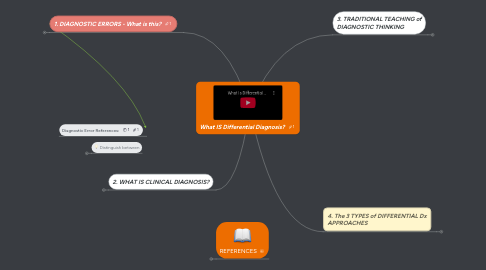
1. 1. DIAGNOSTIC ERRORS - What is this?
1.1. Dx that is:
1.1.1. MISSED
1.1.2. WRONG
1.1.3. DELAYED
1.2. Frequency of Dx Errors
1.2.1. Clinical Studies: 5-15%
1.2.2. Autopsy studies ~ 5% lethal Dx Error w/25% Overall
1.2.3. Harvard Medical Practice Study:
1.2.3.1. More likely to cause harm by Dx Error than by Drugs (14% vs. 9%)
1.2.4. Misdiagnosis considered Negligent - 75%
1.3. Causes of Dx Errors
1.3.1. Graber et al
1.3.1.1. Restrospective Study over 5 yrs in major academic med cntrs ~ 100 cases of Dx Errors - Avg. 5.9 errors / case
1.3.1.2. No fault - 44%
1.3.1.3. System-related 65%
1.3.1.4. Cognitive 74%
1.4. TYPES
1.4.1. COGNITIVE ERRORS
1.4.1.1. Inadequate Knowledge
1.4.1.2. Faulty Data Gathering
1.4.1.3. Faulty Information Processing
1.4.1.4. Faulty Metacognition
1.4.2. SYSTEM RELATED
1.4.2.1. problems with policies and procedures
1.4.2.2. inefficient processes
1.4.2.3. teamwork
1.4.2.4. communication
2. Distinguish between
2.1. Error (PROCESS)
2.2. Harm (OUTCOME)
3. 2. WHAT IS CLINICAL DIAGNOSIS?
3.1. ..."An Effort to Recognize the Class to which a patient's illness belongs so that, based on OUR PRIOR EXPERIENCE with THAT CLASS, the subsequent clinical acts we can afford to carry out, and the patient is willing to follow, will maximize that patient's health"... Sackett DL. Clinical Epidemiology, 2/e, 1991
4. Diagnostic Error References:
5. REFERENCES
5.1. Graber ML. The incidence of diagnostic error in medicine. BMJ Qual Saf. 2013;22(suppl 2):ii21–ii27....
5.2. Singh H, Giardina TD, Meyer AN, Forjuoh SN, Reis MD, Thomas EJ. Types and origins of diagnostic errors in primary care settings. JAMA Intern Med. 2013;173(6):418–425.
5.3. Balogh E, Miller BT, Ball J, eds. Institute of Medicine; Committee on Diagnostic Error in Health Care. Improving Diagnosis in Health Care. Washington, DC: The National Academies Press; 2015
5.4. Croskerry P, Cosby KS, Schenkel SM, Wears RL, eds. Patient Safety in Emergency Medicine. Philadelphia, Pa.: Lippincott Williams & Wilkins; 2009.
5.5. Wellbery C. Flaws in clinical reasoning: a common cause of diagnostic error. Am Fam Physician. 2011;84(9):1042–1048
5.6. Graber ML, Franklin N, Gordon R. Diagnostic error in internal medicine. Arch Intern Med. 2005;165(13):1493–1499.
5.7. Schiff GD, Hasan O, Kim S, et al. Diagnostic error in medicine: analysis of 583 physician-reported errors. Arch Intern Med. 2009;169(20):1881–1887.
5.8. Graber ML, Kissam S, Payne VL, et al. Cognitive interventions to reduce diagnostic error: a narrative review. BMJ Qual Saf. 2012;21(7):535–557.
5.9. Singh H, Graber ML, Kissam SM, et al. System-related interventions to reduce diagnostic errors: a narrative review. BMJ Qual Saf. 2012;21(2):160–170.
5.10. McDonald KM, Matesic B, Contopoulos-Ioannidis DG, et al. Patient safety strategies targeted at diagnostic errors: a systematic review. Ann Intern Med. 2013;158(5 pt 2):381–389.
6. 3. TRADITIONAL TEACHING of DIAGNOSTIC THINKING
6.1. Diagnostic Thinking
6.1.1. Implicit
6.1.2. Haphazard
6.1.3. Fragmented & Asynchronous
6.2. Curricular Context:
6.2.1. Overcrowded
6.2.2. Incoherent
6.2.3. Segregated
6.2.4. Devalued
7. 4. The 3 TYPES of DIFFERENTIAL Dx APPROACHES
7.1. PERCEPTUAL
7.1.1. RAPID Dx
7.1.2. PATTERN RECOGNITION
7.1.2.1. SKILL-BASED
7.1.3. AUTOMATIC - Lends to Speed
7.1.4. "Pre-analytic" Phase to Perception
7.1.5. Requires Familiarity from Experience
7.1.6. EXPERT MODE ~ 80% cases in their field
7.1.7. WE ALL USE THIS MODE
7.1.8. LIMITATIONS OF PERCEPTUAL MODE
7.1.8.1. NEEDS LOTS OF KNOWLEDGE
7.1.8.2. NEEDS LOTS OF EXPERIENCE
7.1.8.3. CANNOT HANDLE DIRECT DIAGNOSIS OF NEW DISEASE OR DISORDER
7.2. ANALYTICAL
7.2.1. Recognize PROBLEM
7.2.2. RECALL - Knowledge
7.2.3. Use above to MAKE INFERENCES & DRAW CONCLUSIONS
7.2.4. Derive UNIQUE DIAGNOSTIC SOLUTION for THIS Patient's Illness
7.2.5. COHERENT NARRATIVE
7.2.6. SLOWER & DELIBERATE PROCESS
7.2.7. EXPLICIT , STRUCTURED KNOWLEDGE NEED
7.2.8. REQUIRES KNOWLEDGE & REASONING
7.2.9. EXPERT USE ~ 20% cases in their fields
7.2.10. MUST BE LEARNED
7.2.11. LIMITATIONS OF ANALYTICAL MODE
7.2.11.1. TIME CONSUMING
7.3. DUAL PROCESS
7.3.1. Uses both Perceptual & Analytics Modes
7.3.2. I USE THIS THE MOST
